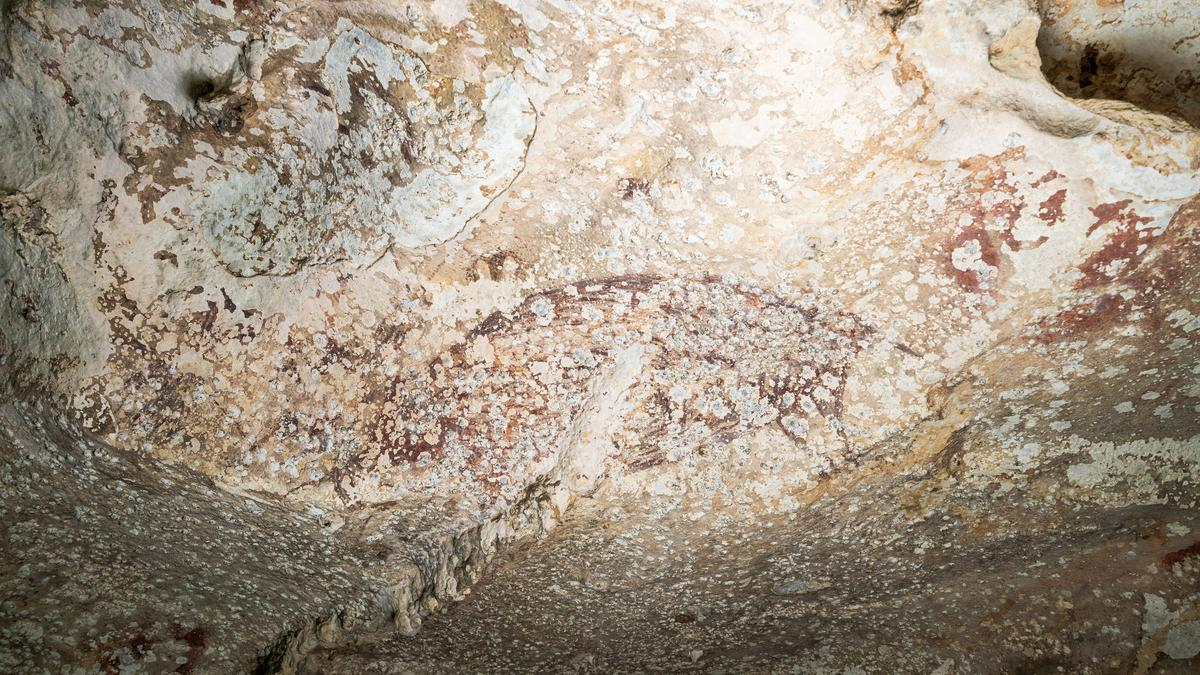- Courses
- GS Full Course 1 Year
- GS Full Course 2 Year
- GS Full Course 3 Year
- GS Full Course Till Selection
- Answer Alpha: Mains 2025 Mentorship
- MEP (Mains Enrichment Programme) Data, Facts
- Essay Target – 150+ Marks
- Online Program
- GS Recorded Course
- Polity
- Geography
- Economy
- Ancient, Medieval and Art & Culture AMAC
- Modern India, Post Independence & World History
- Environment
- Governance
- Science & Technology
- International Relations and Internal Security
- Disaster Management
- Ethics
- NCERT Current Affairs
- Indian Society and Social Issue
- NCERT- Science and Technology
- NCERT - Geography
- NCERT - Ancient History
- NCERT- World History
- NCERT Modern History
- CSAT
- 5 LAYERED ARJUNA Mentorship
- Public Administration Optional
- ABOUT US
- OUR TOPPERS
- TEST SERIES
- FREE STUDY MATERIAL
- VIDEOS
- CONTACT US
World's Oldest Cave Painting in Indonesia Shows a Pig and People
World's Oldest Cave Painting in Indonesia Shows a Pig and People

Location: Leang Karampuang cave, Maros-Pangkep region, South Sulawesi province, Indonesia
Age: At least 51,200 years old
Significance: The oldest-known confidently dated cave painting in the world, predating European cave paintings by at least 10,000 years.
Discovery and Location:
The world's oldest known cave painting was discovered in the Leang Karampuang cave, located in the Maros-Pangkep region of South Sulawesi province, Indonesia. This finding is part of a series of significant archaeological discoveries in the limestone caves of this area, which have been yielding groundbreaking insights into early human art and culture.
The Painting:
Description:
The painting depicts a complex scene with three human-like figures interacting with a wild pig. It's rendered in a single shade of dark red pigment, likely derived from ochre. The pig is portrayed standing upright, while the human figures are smaller and positioned around it. One figure appears to be holding an object near the pig's throat, another is positioned above the pig's head in an inverted posture, and the third figure is larger, possibly wearing an elaborate headdress and holding an unidentified object.
Age and Dating Method:
The painting has been dated to at least 51,200 years old, making it the oldest confidently dated cave painting in the world. This age was determined using an innovative dating technique:
- Scientists focused on calcium carbonate crystals that had formed naturally on top of the painting.
- Using a laser, they dated these crystals, which provide a minimum age for the underlying artwork.
- This method is considered more reliable than previous dating techniques and is expected to revolutionize rock art dating globally.
Significance:
Historical Context:
- Predates European Cave Art: This discovery challenges the long-held assumption that Europe was the birthplace of cave art. The Indonesian painting predates the oldest European cave paintings, such as those at El Castillo in Spain (dated to about 40,800 years ago), by at least 10,000 years.
- Early Human Migration: The age of the painting aligns with theories about early human migration. It may be associated with the first wave of Homo sapiens that moved through the region, eventually reaching Australia about 65,000 years ago during their migration out of Africa.
Artistic and Cultural Implications:
- Storytelling in Art: The scene is interpreted as a narrative, making it the oldest known evidence of storytelling in art. This suggests that the capacity for complex narrative thinking and artistic expression emerged much earlier in human history than previously thought.
- Advanced Cognitive Abilities: The sophistication of the painting contradicts notions that early humans were primitive in their thinking or artistic abilities. It demonstrates advanced mental capacity, including abstract thinking and symbolic representation.
- Cultural Sophistication: The detailed scene, possibly depicting hunting or spiritual practices, indicates a rich cultural life among these early human populations.
Comparative Context:
- Other Sulawesi Discoveries: Another significant find in the region is a cave painting from Leang Bulu' Sipong 4, dated to at least 48,000 years old, which depicts part-human, part-animal figures hunting pigs and dwarf buffalo.
- Global Perspective: This discovery, along with others in Southeast Asia, is shifting the focus of early human art studies from Europe to Asia, suggesting a more complex and diverse picture of early human cultural development.
Unanswered Questions:
- Identity of the Artists: Little is known about the specific group of people who created these paintings.
- Meaning of the Scene: The exact interpretation of the interaction between the human-like figures and the pig remains uncertain.
- Artistic Techniques: Details about the pigments used and the methods of application are still being studied.
Future Research Directions:
- Further exploration of caves in the region for more artistic discoveries.
- Refinement of dating techniques to potentially push back the age of known artworks.
- Interdisciplinary studies combining archaeology, anthropology, and cognitive science to better understand the mental and cultural capabilities of early humans.
Previous Discoveries in Sulawesi
Before this latest finding, the oldest known cave painting in Sulawesi was dated to at least 45,500 years ago. This new discovery pushes back the timeline of cave art in the region by nearly 6,000 years, further emphasizing the importance of Southeast Asia in early human cultural development.
Expert Perspectives:
The significance of this discovery is highlighted by quotes from the archaeologists involved:
- Maxime Aubert, Griffith University archaeologist: "We, as humans, define ourselves as a species that tells stories, and this is the oldest evidence of us doing that."
- Adam Brumm, Griffith University archaeologist: "This discovery of very old cave art in Indonesia drives home the point that Europe was not the birthplace of cave art, as had long been assumed."
About Leang Karampuang Cave:
- Geological Features: Leang Karampuang is a limestone cave, typical of the karst landscape in the Maros-Pangkep region of South Sulawesi.
- Archaeological Importance: The cave has proven to be a treasure trove of prehistoric art, with this latest discovery being the most significant to date.
- Cave Environment: Like many limestone caves, Leang Karampuang likely has a stable environment that has contributed to the preservation of the ancient artwork. The formation of calcite deposits over the paintings has been crucial in both preserving and dating the art.
- Ongoing Research: The cave continues to be a site of active archaeological investigation, with researchers expecting to uncover more insights into early human habitation and artistic expression in the region.
- Conservation Challenges: With the discovery of such ancient and valuable artwork, there will likely be increased focus on preserving the cave and its contents from both natural degradation and human interference.
This discovery not only rewrites the timeline of human artistic expression but also provides valuable insights into the cognitive and cultural evolution of our species, highlighting the global nature of human creativity and storytelling.
Must Check: Best IAS Coaching In Delhi



